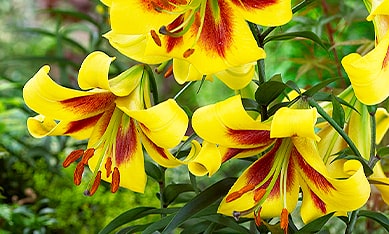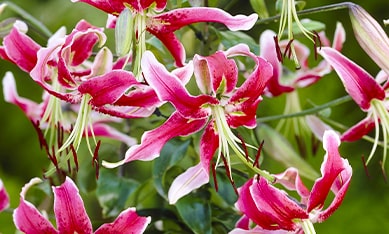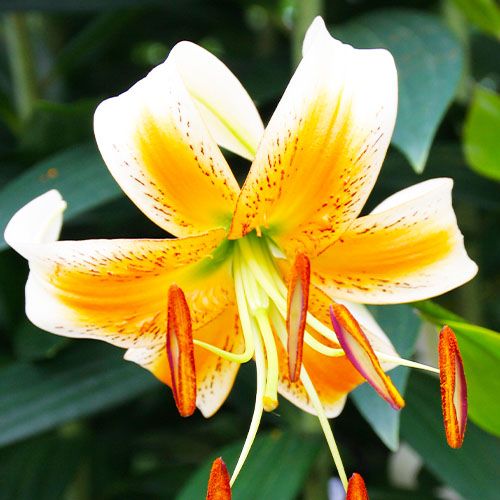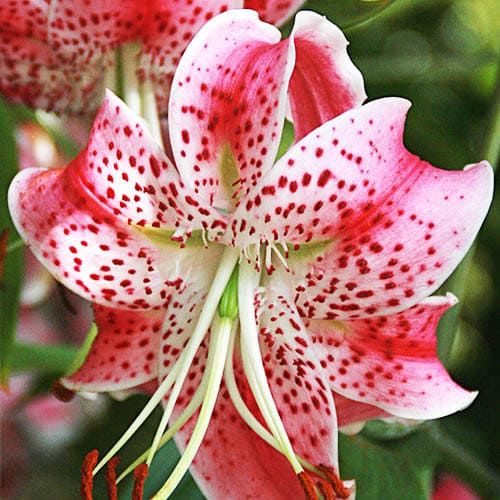Turkish Cap Lilies
Turkish Cap Lilies
Last Reviews
All About Turks Cap Lilies: Facts, Care Tips, and Propagation Techniques
Turks cap lilies are a group of true lilies with distinctive flowers with recurved petals and prominent stamens. They are native to Europe, Asia, and North America, and have been cultivated for centuries for their beauty and fragrance. Turks cap lilies are also known as martagon lilies, mountain lilies, or turban lilies, depending on the species and variety.
Turks cap lilies are easy to grow and care for, as long as they have well-drained soil enriched with organic matter, partial shade, and adequate moisture. They can be grown in borders, beds, containers, or naturalized in woodland or meadow gardens. They attract hummingbirds, butterflies, and bees with their nectar-rich flowers.
Turks cap lilies can be propagated by seed, bulb division, or stem bulbils. Seeds can be sown in pots or trays in a cold frame as soon as they are ripe, and germinate in one to two years. Bulb division can be done in autumn or spring, when foliage dies down or emerges. Stem bulbs are small bulbs that form along the stem of some species and varieties, and can be detached and planted in pots or directly in the ground.
The Meaning and Symbolism Behind Turks Cap Lilies: What Do They Represent?
Turks cap lilies have different meanings and symbolism depending on their color, origin, and cultural context. Some of the common associations are:

- Red Turks cap lilies symbolize passion, love, courage, and confidence. They are often given as a romantic gesture or sign of admiration.
- Pink Turks cap lilies symbolize femininity, grace, elegance, and charm. They are often given as a gift to celebrate a special occasion or express gratitude.
- Yellow Turks cap lilies symbolize joy, happiness, friendship, and optimism. They are often given as a token of appreciation or encouragement.
- White Turks cap lilies symbolize purity, innocence, peace, and spirituality. They are often given as a gesture of sympathy or condolence.
- Orange Turks cap lilies symbolize enthusiasm, creativity, energy, and adventure. They are often given to express admiration or congratulations.
Turks cap lilies also have historical and religious significance. For example:
- In Greek mythology, Turks cap lilies were associated with Hera, the queen of the gods and the goddess of marriage and childbirth. According to legend, she created the Milky Way by spilling her breast milk while nursing Hercules, her son by Zeus. Some milk drops fell on the earth and turned into Turks cap lilies.
- In Christianity, Turks cap lilies were associated with the Virgin Mary, the mother of Jesus Christ. According to legend, she shed tears at the foot of the cross where Jesus was crucified, and her tears turned into Turks cap lilies. They were also seen as a symbol of her purity and humility.
- In China, Turks cap lilies were associated with Confucius, the famous philosopher and teacher. According to legend, he was so impressed by the beauty and fragrance of Turks cap lilies that he compared them to his own teachings.
Types of Turks Cap Lilies: A Guide to Popular Varieties and Their Characteristics
Turks cap lilies come in a variety of shapes, sizes, colors, and blooming cycles. The most well-liked types include:
The most common and widely distributed variety of Turks cap lily is Lilium martagon. It blooms purple-pink flowers with black patterns and yellow anthers. It blooms in the early summer and grows to a height of 1.5 meters.
The tallest native American lily is Lilium superbum. It has orange-red flowers with green stars in the center. It may grow up to 2 meters tall and blooms in the middle to end of summer.
Lilium hansonii, a rare and endangered species native to Korea and Japan. Brown anthers, yellow flowers, and red borders are its distinguishing traits. Early summer is when it blooms, and it may grow up to one meter tall.
Lilium tsingtauense: a Chinese dwarf variety. It has yellow flowers with purple patterns and orange anthers. It blooms in late spring to early summer and grows up to 30 cm tall.
Lilium henryi: This hybrid species from China features long, curving anthers and orange blooms with black markings. It may reach 2.5 meters and blooms in the late summer. It is extremely robust, disease-resistant, and tolerant of lime soil. In honor of the Irish adventurer who found it, it is sometimes frequently referred to as tiger lily or Henrys lily.
Asiatic vs. Turks Cap Lilies: Differences in Appearance, Care, and More
Asiatic and Turks cap lilies are two different groups of true lilies that have some similarities and differences. Here are some of the main points to consider:
Appearance: Asiatic lilies have upright, bowl-shaped flowers with straight petals and short stamens. They come in a wide range of colors, from white to yellow, pink, red, orange, and even black. Turks cap lilies have nodding, turban-shaped flowers with recurved petals and long stamens. They usually have orange or pink flowers with dark spots or stripes.
Care: Asiatic lilies are easy to grow and maintain for, as they adapt to various soil types and sun exposures. They prefer full sun to partial shade, moist but well-drained soil, and regular fertilization. Turks cap lilies are also easy to grow and care for. However, they need more organic matter and moisture in the soil, and more shade than Asiatic lilies. They prefer partial shade, rich soil, and consistent watering.
Bloom time: Asiatic lilies bloom earlier than Turks cap lilies, usually from late spring to early summer. Turks cap lilies bloom later, in late summer.
Fragrance: Asiatic lilies are usually scentless or have a faint fragrance. Turks cap lilies are often fragrant or spicy.
Planting Turks Cap Lilies: How to Grow These Beautiful Blooms in Your Garden
Turks cap lilies are an excellent addition to any garden, as they provide stunning color and texture, attract pollinators, and naturally grow easily. Here are some tips on how to plant and grow these lovely flowers:
1. Choose a location: Turks cap lilies need partial shade, as too much sun can scorch their leaves and fade their colors. They also need well-drained soil enriched with organic matter, such as compost or leaf mold. Avoid planting them in heavy clay or soggy soil, as they rot easily.
2. Plant the bulbs: Turks cap lily bulbs should be planted in spring or fall, when the soil is cool but not frozen. Dig a hole about 8 inches deep and wide, and place the bulb with the pointed end up. Cover with soil and water well. Space the bulbs about 8 inches apart for smaller varieties, or 12 inches apart for larger ones.
3. Mulch and water: Turks cap lilies need consistent moisture during their growing season, especially when blooming. Water them regularly, but avoid overwatering or letting them sit in waterlogged soil. Mulch around the plants with organic material to conserve moisture and prevent weeds.
4. Fertilize and stake: Turks cap lilies benefit from a balanced fertilizer applied once in spring when they start growing, as well as again when they start blooming. Use a low-nitrogen formula to avoid excessive foliage growth at the expense of flowers. Stake the plants if they become too tall or floppy, using bamboo canes or metal supports.
When Do Turks Cap Lilies Bloom? A Seasonal Guide to Flowering Times
Depending on the species and variety, Turks cap lilies can bloom anywhere between the middle and end of summer. They typically have a long-lasting display of color and fragrance that lasts for several weeks. Various varieties of Turks cap lilies have different flowering seasons, as shown by the following examples:
- Lilium martagon: Typically blooming in June or July, this species blooms from early to midsummer.
- Lilium superbum: This species blooms in the middle to end of summer, typically in July or August.
- Lilium hansonii: This species blooms from the beginning to the middle of the summer, typically in June or July.
- Lilium tsingtauense: This species blooms in May or June typically, but can bloom anytime from late spring to early summer.
- Lilium henryi: This species blooms in the months of August or September, but it can also bloom in the late summer or early fall.
Are Turks Cap Lilies Deer Resistant? Tips for Protecting Your Garden
Turks cap lilies are deer resistant, meaning that deer usually avoid eating them or browsing on them. This is because Turks cap lilies contain alkaloids that are toxic or bitter to deer and other animals. However, deer resistance is not a guarantee, and some deer may still nibble on Turks cap lilies if they are hungry or curious enough.
Turks cap lilies can benefit from being planted near other plants that deer dislike, such as lavender, sage, rosemary, mint, or garlic. These plants can create a barrier or a deterrent for deer with their strong scents or flavors.
You can also spray your Turks cap lilies with commercial or homemade repellents that contain ingredients such as hot pepper, garlic, vinegar, or soap. These repellents can make your plants unappealing to deer and other animals. You can also use deterrents such as motion-activated sprinklers, lights, or noise-makers to scare away deer from your garden.
The most effective way to keep deer out of your garden is to fence it with a sturdy and tall fence that deer cannot jump over or go through. You can use wire mesh, wood, or metal fencing, and make sure it is at least 8 feet high and buried at least 1 foot deep. You can also add electric wires or slanted tops to make it more difficult for deer to climb over.
Turks Cap Lily Bulbs: How to Store and Replant for Year-Round Blooms
Turks cap lily bulbs are perennial bulbs that can be left in the ground over winter in zones 5 to 8. However, if you live in a colder zone or want to move your bulbs to a different location, you can dig them up and store them for replanting later. Here are some steps to store and replant your Turks cap lily bulbs:

1. Dig up the bulbs: After the foliage dies down in autumn, dig them up with a spade or a fork, avoiding damaging them. Shake off any excess soil and cut off any remaining stems or roots.
2. Cure the bulbs: Place the bulbs in a cool, dry, and well-ventilated place for a few days to cure them. This will help them harden and prevent rotting.
3. Store the bulbs: Pack the bulbs loosely in paper bags, cardboard boxes, or mesh bags filled with peat moss, vermiculite, sawdust, or shredded newspaper. Label the bags or boxes with the bulbs name and variety. Store them in a cool, dark, and dry place such as a basement, garage, or shed. Check them periodically for signs of mold, rot, or pests, and discard any damaged bulbs.
4. Replant the bulbs: In spring or fall, replant the bulbs in another location or in pots. Choose a site with partial shade and well-drained soil enriched with organic matter. Dig holes about 8 inches deep and wide, and place the bulbs with the pointed ends up. Cover with soil and water well. Space the bulbs about 8 inches apart for smaller varieties, or 12 inches apart for larger ones.
Turks Cap Lily Bulbs: How to Store and Replant for Year-Round Blooms
Turks cap lily is a stunning wildflower native to eastern and central North America. It produces large, nodding, turban-shaped flowers with recurved petals in shades of yellow, orange, red, or pink. The flowers have a green star in the center, and they are often spotted with dark purple or brown spots. Turks cap lily is also known as swamp lily, lily royal, or American tiger lily.
Turks cap lily is a great choice for naturalizing in moist meadows, woodlands, swamps, or bogs. It attracts hummingbirds, butterflies, and bees with its nectar and fragrance. It can also be grown in containers or as a cut flower for bouquets.
If you want to enjoy Turks cap lily beauty year after year, you need to know how to store and replant the bulbs properly. Here are some useful tips to help you:
1. Choose healthy bulbs. When buying Turks cap lily bulbs, look for firm, plump, and disease-free ones. Avoid bulbs that are soft, shriveled, moldy, or damaged. The bulbs should have roots attached and scales on the top. The larger the bulb, the more flowers it produces.
2. Plant the bulbs in the fall. The best time to plant Turks cap lily bulbs is late September to early October, before the ground freezes. This will give them enough time to establish roots before winter. Choose a location with full sun to partial shade and well-drained soil enriched with organic matter. Dig a hole about 6 inches deep and 8 inches wide for each bulb. Place the bulb in the hole with the roots pointing down and the scales pointing up. Cover the bulb with soil and water well. Space the bulbs about 12 inches apart.
3. Mulch the planting area. To protect the bulbs from frost and weeds, apply mulch over the planting area. You can use shredded leaves, straw, pine needles, or bark chips as mulch. The mulch should be about 2 to 3 inches thick and cover the entire planting area. Remove the mulch in spring when the shoots emerge from the ground.
4. Water and fertilize regularly. Turks cap lily bulbs need regular watering and fertilizing during the growing season. Water them once a week or more often if the soil feels dry. Avoid overwatering or letting the soil get soggy, as this can cause rotting or fungal diseases. Fertilize them once a month with a balanced liquid fertilizer diluted to half strength. Stop fertilizing after the flowers fade.
5. Deadhead and cut back. To encourage more blooms and prevent seed formation, deadheads spent flowers as soon as they wilt. Cut off the flower stalks at the base with a sharp knife or scissors. Do not cut off the leaves, as they are needed for photosynthesis and to store energy for next years growth. Let the leaves die back naturally in the fall and then cut them off at ground level.
6. Dig up and store the bulbs. If you live in an area where winters are very cold (zone 6 or lower), you may need to dig up and store your Turks cap lily bulbs for winter protection. You can also do this if you want to move them to a different location or divide them for propagation. The best time to pick up the bulbs is after the first frost in fall, when the foliage has turned yellow or brown. Use a garden fork or spade to gently lift the bulbs from the ground without damaging them. Shake off any excess soil and remove any dead or diseased parts. Let the bulbs dry in a cool, airy place for a few days until cured.
7. Store the bulbs in a cool, dry place. Once the bulbs are cured, you can store them in a cool, dry place until spring planting time. You can use paper bags, cardboard boxes, mesh bags, or plastic containers with ventilation holes as storage containers.
Frequently asked questions about Spring Flowering Turkish Cap Lilies
How deep should I plant the Turk's cap lily bulbs?
As a rule, Turk's cap lily bulbs should be planted about twice as deep as the height of the bulb itself. This usually means a depth of around 10-15 centimetres.
Where can I buy Turk's cap lily bulbs?
You can buy Turk's cap lily bulbs in our online shop. We offer a selection of high-quality bulbs in different varieties.
What care do Turk's cap lily bulbs need?
Turk's cap lilies are relatively easy to care for. They require well-drained soil, regular watering and a sunny to semi-shady location. You can find further care instructions in our planting guide.
Can I grow Dutch Turk's cap lily bulbs in pots?
Yes, Turk's cap lily bulbs can be grown in pots. Choose a sufficiently large pot with good drainage and use a high-quality potting soil. Make sure the pot gets enough sunlight.
Which varieties of Danish Turk's cap lilies do you offer in your shop?
In our shop you will find a selection of different varieties of Turk's cap lilies, including classic and rare varieties. Take a look at our assortment to discover the available options.













